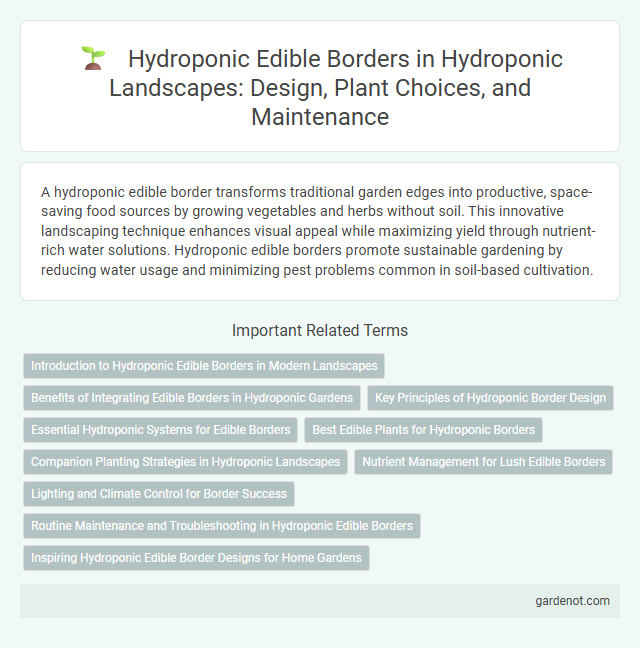A hydroponic edible border transforms traditional garden edges into productive, space-saving food sources by growing vegetables and herbs without soil. This innovative landscaping technique enhances visual appeal while maximizing yield through nutrient-rich water solutions. Hydroponic edible borders promote sustainable gardening by reducing water usage and minimizing pest problems common in soil-based cultivation.
Introduction to Hydroponic Edible Borders in Modern Landscapes
Hydroponic edible borders integrate soil-free cultivation techniques with landscape design to create sustainable, space-efficient food-growing solutions. Utilizing nutrient-rich water solutions, these borders support a wide variety of edible plants, including herbs, leafy greens, and small vegetables, promoting year-round harvests in urban and residential settings. Their modern application enhances aesthetic appeal while providing fresh, pesticide-free produce, reducing water usage by up to 90% compared to traditional soil gardening.
Benefits of Integrating Edible Borders in Hydroponic Gardens
Integrating edible borders in hydroponic gardens enhances space efficiency by combining aesthetic appeal with food production, maximizing limited growing areas. These borders promote biodiversity and natural pest control by attracting beneficial insects and supporting pollinators, reducing the need for chemical interventions. Hydroponic edible borders also improve microclimates around plants, leading to healthier growth cycles and increased yields of fresh, nutrient-rich produce.
Key Principles of Hydroponic Border Design
Hydroponic edible borders maximize space efficiency by combining vertical and horizontal planting techniques to optimize light exposure and airflow for each crop. Key principles include selecting compatible plant species with similar nutrient and water requirements, using modular systems for flexibility and ease of maintenance, and incorporating automated nutrient delivery and monitoring to maintain optimal growing conditions. Proper drainage and root zone aeration are essential to prevent waterlogging and promote healthy plant growth in hydroponic border setups.
Essential Hydroponic Systems for Edible Borders
Essential hydroponic systems for edible borders include nutrient film technique (NFT), deep water culture (DWC), and aeroponics, which provide efficient nutrient delivery and oxygenation for optimal plant growth. These systems enable precise control over nutrient levels and water use, supporting the cultivation of herbs, leafy greens, and other edible plants in compact border spaces. Implementing hydroponic edible borders maximizes yield, ensures faster growth cycles, and reduces soil-related issues such as pests and diseases.
Best Edible Plants for Hydroponic Borders
Hydroponic edible borders thrive with nutrient-rich water systems that support high-yield varieties such as lettuce, basil, and kale, which excel in controlled environments. These plants optimize space and promote continuous harvest cycles, benefiting from the precise root zone oxygenation and pH balance intrinsic to hydroponic setups. Choosing fast-growing, compact herbs and leafy greens ensures a vibrant, productive edible border that combines visual appeal with culinary utility.
Companion Planting Strategies in Hydroponic Landscapes
Companion planting strategies in hydroponic edible borders enhance nutrient uptake and pest resistance by pairing compatible plants such as basil with tomatoes or lettuce with radishes. Implementing these combinations within hydroponic systems maximizes space efficiency and promotes healthier growth without soil-borne diseases. Optimizing plant synergy improves yield and maintains ecological balance in controlled environment agriculture.
Nutrient Management for Lush Edible Borders
Effective nutrient management in hydroponic edible borders ensures optimal growth and vibrant foliage by maintaining a balanced supply of essential macronutrients such as nitrogen, phosphorus, and potassium. Regular monitoring of pH and electrical conductivity (EC) levels allows precise adjustments in nutrient solutions, promoting nutrient uptake and preventing deficiencies or toxicities. Implementing automated dosing systems enhances consistency, resulting in lush, productive edible borders with superior flavor and texture.
Lighting and Climate Control for Border Success
Hydroponic edible borders thrive under precise lighting conditions, requiring 12-16 hours of LED or full-spectrum light daily to mimic natural sunlight for optimal photosynthesis. Consistent climate control with temperatures maintained between 65-75degF and humidity levels around 50-70% ensures robust plant growth and minimizes disease risk. Automated systems regulating light intensity, temperature, and ventilation enhance crop yield and border success in hydroponic landscapes.
Routine Maintenance and Troubleshooting in Hydroponic Edible Borders
Routine maintenance of hydroponic edible borders involves regular monitoring of nutrient solution levels, pH balance, and plant health to ensure optimal growth conditions. Troubleshooting common issues like nutrient deficiencies, root rot, or pest infestations requires timely adjustments to nutrient concentrations, improved aeration, and integrated pest management strategies. Consistent upkeep promotes robust yields and extends the lifespan of the hydroponic edible border system.
Inspiring Hydroponic Edible Border Designs for Home Gardens
Hydroponic edible borders transform home gardens by integrating nutrient-rich water systems that support vigorous growth of herbs, leafy greens, and vegetables in compact spaces. Innovative vertical and tiered designs maximize yield and aesthetic appeal while conserving soil and water resources. These setups offer year-round freshness, easy harvesting, and sustainable gardening solutions tailored for urban and suburban environments.
Hydroponic edible border Infographic

 gardenot.com
gardenot.com